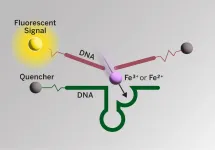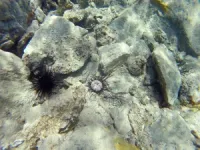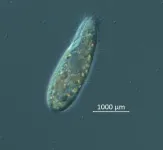(Press-News.org) There is a growing body of evidence that iron in the brain may play a role in Alzheimer’s disease. Lending weight to that idea, a new imaging probe has for the first time shown that in the same regions of the brain where the amyloid beta plaques associated with Alzheimer’s occur, there is also an increase in iron redox, meaning the iron in these regions is more reactive in the presence of oxygen. Their imaging probe could yield even more details about the causes of Alzheimer’s and help in the search for new drugs to treat it.
A team from The University of Texas at Austin and the University of Illinois at Urbana-Champaign published a study today on the new imaging technique and findings in Science Advances.
“The link between iron redox and Alzheimer’s disease has been a black box,” said Yi Lu, corresponding author and professor of chemistry at UT Austin. “The most exciting part to me is that we now have a way to shine light into this black box so that we can begin to understand this whole process in much more detail.”
About a decade ago, scientists discovered ferroptosis, a process in the body that is dependent on elevated iron levels, leads to cell death and plays a key role in neurodegenerative diseases, such as Alzheimer's. Using magnetic resonance imaging on living Alzheimer’s patients, scientists have observed that these patients tend to have elevated iron levels in the brain, although that method doesn’t differentiate between different forms of iron. Together, these findings suggested that iron might play a role in destroying brain cells in Alzheimer’s patients.
For the new study, the researchers developed DNA-based fluorescent sensors that can detect two different forms of iron (Fe2+ and Fe3+) at the same time in cell cultures and in brain slices from mice genetically modified to mimic Alzheimer’s. One sensor glows green for Fe2+ and the other glows red for Fe3+. This is the first imaging technique that can simultaneously detect both forms of iron in cells and tissue while also indicating their quantity and spatial distribution.
“The best part about our sensor is that we can now visualize the changes of Fe2+ and Fe3+ and their ratios in each location,” said Yuting Wu, a co-first author of the study and a postdoctoral researcher in Lu’s lab at UT Austin. “We can change one parameter at a time to see if it changes the plaques or the oxidative states of iron.”
That ability could help them better understand why there is an increased ratio of Fe3+ to Fe2+ in the location of amyloid beta plaques and whether increased iron redox is involved in forming the plaques.
Another key question is whether the iron redox is directly involved in cell death in Alzheimer’s, or simply a byproduct. The researchers plan to explore this question in Alzheimer’s mice. If further research determines that iron and its redox changes indeed cause cell death in Alzheimer’s patients, that information could provide a potential new strategy for drug development. In other words, perhaps a drug that change the ratio Fe3+ to Fe2+ could help protect brain cells. The new imaging probe could be used to test how well drug candidates work at changing the ratio.
To develop the sensors, the scientists first hired a commercial lab to produce a library of 100 trillion short DNA strands, through a chemical process called oligonucleotide synthesis. They then conducted a screening process to find those strands that recognize — or in chemistry parlance “bind tightly to and conduct a catalytic reaction with” — a specific form of iron and not any other forms. To complete the sensors, other components were added including molecules called fluorophores that glow in a specific color when the probe recognizes the specific form of iron.
Lu, who moved his lab to UT Austin from the University of Illinois at Urbana-Champaign in the summer of 2021, collaborated with researchers there including professor of chemistry Liviu Mirica.
This work was supported by the National Institutes of Health, the Alzheimer’s Association and the Robert A. Welch Foundation. Lu holds the Richard J.V. Johnson – Welch Regents Chair in Chemistry.
END
Newfound link between Alzheimer’s and iron could lead to new medical interventions
What if amyloid beta plaques aren’t the main cause of Alzheimer’s disease?
2023-04-19
ELSE PRESS RELEASES FROM THIS DATE:
Scientists identify 2022 sea urchin killer
2023-04-19
TAMPA, Fla. (APRIL 19, 2023) – The search for the 2022 killer that decimated the long-spined sea urchin population in the Caribbean and along Florida’s east coast is over. A team of researchers organized by Mya Breitbart, Distinguished University Professor at the University of South Florida’s College of Marine Science, identified a single-celled organism called a ciliate as the cause of a massive die-off event to a marine animal vital to coral reef health.
Their findings were reported in Science Advances.
“We’re beyond ...
How the pandemic exacerbated racial inequalities in the US criminal legal system
2023-04-19
APRIL 19, 2023
As Covid roared through prisons in 2020, the U.S. prison population fell by as much as 30 percent, creating the largest, fastest reduction in prison population in American history. But this decarceration disproportionately benefited white incarcerated people, sharply increasing the fraction of incarcerated Black and Latino people. A new study in Nature shows that this increased racial disparity in U.S. prisons stems in large part from a long-standing problem with the justice system: Non-white people tend ...
MD Anderson Research Highlights for April 19, 2023
2023-04-19
HOUSTON ― The University of Texas MD Anderson Cancer Center’s Research Highlights showcases the latest breakthroughs in cancer care, research and prevention. These advances are made possible through seamless collaboration between MD Anderson’s world-leading clinicians and scientists, bringing discoveries from the lab to the clinic and back.
Recent developments include effective combination therapies for patients with BRAFV600E mutations, an approach to identify cancer biomarkers in extracellular vesicles, therapeutic strategies for improving ...
A once-stable glacier in Greenland is now rapidly disappearing
2023-04-19
COLUMBUS, Ohio – As climate change causes ocean temperatures to rise, one of Greenland’s previously most stable glaciers is now retreating at an unprecedented rate, according to a new study.
Led by researchers at The Ohio State University, a team found that between 2018 and 2021, Steenstrup Glacier in Greenland has retreated about 5 miles, thinned about 20%, doubled in the amount of ice it discharges into the ocean, and quadrupled in velocity. According to the study, such a rapid change is so extraordinary ...
The Container Store offers $10,000 in scholarships for Charisma Virtual Social Coaching
2023-04-19
The Container Store, the nation’s leading retailer of storage and organization solutions, custom spaces, and in-home organizing services, will fund $10,000 in scholarships for Charisma™ Virtual Social Coaching, a strengths-based social skills training developed by Center for BrainHealth.
Charisma is a personalized, avatar-driven program that provides real-time, unscripted social coaching in a safe, non-threatening virtual environment. Drawing on extensive cognitive neuroscience research, this program is demonstrated to help people with social challenges to ...
Study seeks to define quantum compression
2023-04-19
A study led by Oak Ridge National Laboratory researchers identifies a new potential application in quantum computing that could be part of the next computational revolution.
The study surveys techniques for compressing data generated by sensors in edge computing — which processes data at or near sensors — and compares classical techniques with quantum approaches, which are mostly in development. Compressing data saves storage space and network bandwidth.
Classical computing stores information in bits equal to 0 or 1. Quantum computing stores information in qubits, which can exist ...
Antibody combination provided strong protection against severe COVID-19 in large international trial
2023-04-19
A treatment combining two antibodies against the coronavirus SARS-CoV-2 strongly protected high-risk people with early COVID-19 symptoms from hospitalization and death in an international Phase 2/3 clinical trial conducted in the first half of 2021 and co-led by researchers at Weill Cornell Medicine and NewYork-Presbyterian.
The trial, described in a paper appearing online Apr. 18 in Annals of Internal Medicine, enrolled more than 800 non-hospitalized patients with COVID-19 at high-risk of progression of the disease in the United States and ...
Accredited geriatric emergency departments continue to grow within VA hospitals
2023-04-19
WASHINGTON, D.C.—April 19, 2023—The U.S. Department of Veterans Affairs (VA), the largest integrated healthcare system in the nation, today announced that 60 of its 111 emergency departments have earned Geriatric Emergency Department Accreditation (GEDA) from the American College of Emergency Physicians (ACEP). Another 11 departments are on track to earn the designation in coming months and the VA has plans to expand the program to the majority of its hospitals over the next three years.
Geriatric emergency departments provide specialized care to older veterans and their families during and after a ...
NASA selects NAU researcher for international mission to Martian moons
2023-04-19
A planetary scientist at NAU is part of a Japanese Aerospace Exploration Agency (JAXA) mission to travel to Mars and survey the planet’s two moons, including collecting a sample from one and returning it to Earth.
Christopher Edwards, an associate professor in the Department of Astronomy and Planetary Science, received a six-year, $650,000 grant for the Martian Moons eXploration (MMX) mission awarded by NASA. This goal is to send an uncrewed spacecraft to Mars’ two moons, Phobos and Deimos, to gather information about them. It also will collect surface material from Phobos, a first-of-its-kind attempt.
Edwards, ...
Warm-up time corrects creativity power imbalance
2023-04-19
ITHACA, N.Y. – Power often boosts an employee’s creativity because being powerful liberates the individual from constraints, such as worrying that their ideas will be rejected. However, new research shows that employees who are not in positions of power can become more creative when given time to “warm up” to a task by engaging in the creative task more than once.
“This is important because when people with more power are able to express their creative ideas more than those with less power, ...
LAST 30 PRESS RELEASES:
Electrodes created using light
Second-hand gift-giving is a well-deliberated decision
How human interaction drove evolution to make bears less aggressive
National Poll: Few parents offer teens guidance on healthy eating during holiday season
Cannabis derivatives could provide new ovarian cancer treatments
Raising strong yeast as a petroleum substitute
Clues to the origin of hot Jupiters hidden in their orbits
Canada’s reduced pledge to Global Fund will impact domestic health
1 in 4 children with major traumatic injuries not cared for in pediatric trauma centres
Duke and Duke-NUS’ joint cross-population research to uncover "East-West" differences in disease and care
Scientists to ‘spy’ on cancer- immune cell interactions using quantum technology breakthrough
Tech savvy users have most digital concerns
Making lighter work of calculating fluid and heat flow
Normalizing blood sugar can halve heart attack risk
Lowering blood sugar cuts heart attack risk in people with prediabetes
Study links genetic variants to risk of blinding eye disease in premature infants
Non-opioid ‘pain sponge’ therapy halts cartilage degeneration and relieves chronic pain
AI can pick up cultural values by mimicking how kids learn
China’s ecological redlines offer fast track to 30 x 30 global conservation goal
Invisible indoor threats: emerging household contaminants and their growing risks to human health
Adding antibody treatment to chemo boosts outcomes for children with rare cancer
Germline pathogenic variants among women without a history of breast cancer
Tanning beds triple melanoma risk, potentially causing broad DNA damage
Unique bond identified as key to viral infection speed
Indoor tanning makes youthful skin much older on a genetic level
Mouse model sheds new light on the causes and potential solutions to human GI problems linked to muscular dystrophy
The Journal of Nuclear Medicine ahead-of-print tip sheet: December 12, 2025
Smarter tools for peering into the microscopic world
Applications open for funding to conduct research in the Kinsey Institute archives
Global measure underestimates the severity of food insecurity
[Press-News.org] Newfound link between Alzheimer’s and iron could lead to new medical interventionsWhat if amyloid beta plaques aren’t the main cause of Alzheimer’s disease?





